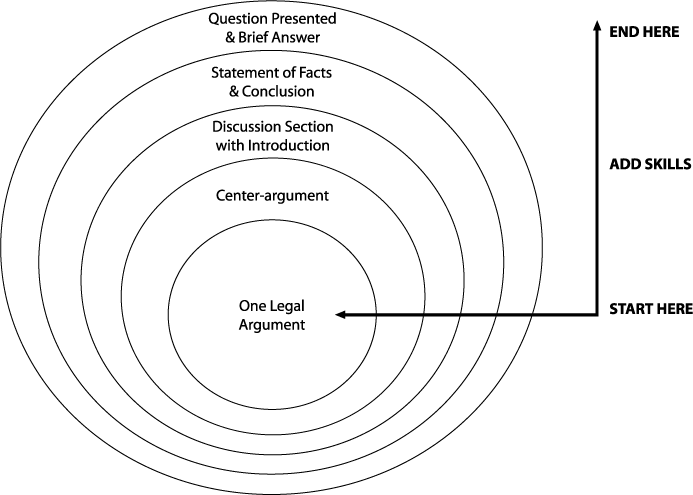Writing Assignments to Use with A Lawyer Writes
A Lawyer Writes would be useless if students were not practicing their legal analysis and writing skills directly after reading about those skills. Thus, this book will be useful only if accompanied with writing assignments. That raises the question of what kinds of writing assignments should accompany A Lawyer Writes.
Because no student can absorb everything at once (how many of us simply jumped onto a bicycle and rode off into the sunset?), we start small. Our initial assignments teach what we believe to be the core skill of legal analysis and writing: building one legal argument (a.k.a. one IRAC, one CREAC, one CREXAC, one CRRPAP). In subsequent assignments, students practice that core skill and add one or two additional skills to their repertoire.
Thus, a typical semester might have the following five writing assignments.
• Draft One Legal Argument
Skill being added: Draft one legal argument (IRAC, CREAC, CREXAC, CRRPAP) that is one paragraph long.
• Draft One Legal Argument with a Counter-argument
Skills being repeated for practice: Drafting one legal argument (on a new topic).
Skill being added: A counter-argument.
• Draft Part of a Memorandum (Closed Memorandum)
Skills being repeated for practice: Drafting one or two arguments (on a new topic), at least one of which has a counter-argument.
Skill being added: An introductory roadmap to those legal arguments; thus, students will have written at least part of a Discussion section of a memo.
Note: Usually this is a closed universe assignment because students have not yet developed the research or analytical skills to find and sort through the necessary authorities.
• Revise and Complete the Memorandum (Containing the Closed Memorandum)
Skills being repeated for practice: Discussion section of a memo, which includes an introduction and two to three legal arguments with counter-argument(s) (at least some of which have been commented upon by the professor).
Skills being added: Statement of Fact and a Final Conclusion.
• Independently Draft a New, More Analytically Complex Memorandum (Open Memo)
Skills being repeated for practice: Statement of Facts, Discussion section of a memo, which includes an introduction and several more complex legal arguments one or more of which has a counter-argument; and a Final Conclusion.
Skill being added: Question Presented and Brief Answer.
Note: Assuming students have developed sufficient research skills, they can conduct the research for this assignment.
These assignments act like concentric circles. At the core is the single legal argument (IRAC, CREAC, CREXAC, CRRPAP). Each assignment builds on the core by adding one or two additional elements.
Obviously, different professors might add skills in a slightly different order. Some professors might want students to write a Statement of Facts with the very first assignment. The above description is not meant to dictate a definitive order, but to illustrate one way in which a professor might start with core analytical and writing skills and build from there.
Designing effective problems is no easy task. To that end, we have provided some initial assignments to help you teach core skills: how to develop one legal argument and how to develop one legal argument with a counter-argument. You can find those assignments and exercises on the webpage for Chapter 6.
With respect to the more complex, closed and open memoranda, we recommend that you visit the Legal Writing Institute’s (LWI) Idea Bank. The Idea Bank is a repository for assignments designed by legal writing professors from across the nation. To gain access to the Idea Bank, you must either be an LWI member or apply for a Teaching Bank Membership. If you are already an LWI member, simply sign in to the LWI website and look for the Teaching Bank link.
If after looking through problems in the Idea Bank you have not found a problem to your liking, you can send an e-mail to the LWI’s e-mail list. The LWI website explains how to send emails to the membership. The legal writing community is very helpful to new teachers, and we encourage you to reach out to other members for help.
If you are a professor teaching in this field you may request a complimentary copy.
To access materials from the previous edition, click here.
